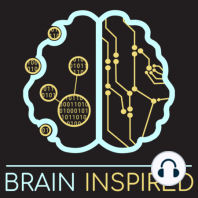105 min listen
BI 140 Jeff Schall: Decisions and Eye Movements
FromBrain Inspired
ratings:
Length:
80 minutes
Released:
Jun 30, 2022
Format:
Podcast episode
Description
Check out my free video series about what's missing in AI and Neuroscience
Support the show to get full episodes and join the Discord community.
Jeff Schall is the director of the Center for Visual Neurophysiology at York University, where he runs the Schall Lab. His research centers around studying the mechanisms of our decisions, choices, movement control, and attention within the saccadic eye movement brain systems and in mathematical psychology models- in other words, how we decide where and when to look. Jeff was my postdoctoral advisor at Vanderbilt University, and I wanted to revisit a few guiding principles he instills in all his students. Linking Propositions by Davida Teller are a series of logical statements to ensure we rigorously connect the brain activity we record to the psychological functions we want to explain. Strong Inference by John Platt is the scientific method on steroids - a way to make our scientific practice most productive and efficient. We discuss both of these topics in the context of Jeff's eye movement and decision-making science. We also discuss how neurophysiology has changed over the past 30 years, we compare the relatively small models he employs with the huge deep learning models, many of his current projects, and plenty more. If you want to learn more about Jeff's work and approach, I recommend reading in order two of his review papers we discuss as well. One was written 20 years ago (On Building a Bridge Between Brain and Behavior), and the other 2-ish years ago (Accumulators, Neurons, and Response Time).
Schall Lab.Twitter: @LabSchall.Related papersLinking Propositions.Strong Inference.On Building a Bridge Between Brain and Behavior.Accumulators, Neurons, and Response Time.
0:00 - Intro
6:51 - Neurophysiology old and new
14:50 - Linking propositions
24:18 - Psychology working with neurophysiology
35:40 - Neuron doctrine, population doctrine
40:28 - Strong Inference and deep learning
46:37 - Model mimicry
51:56 - Scientific fads
57:07 - Current projects
1:06:38 - On leaving academia
1:13:51 - How academia has changed for better and worse
Support the show to get full episodes and join the Discord community.
Jeff Schall is the director of the Center for Visual Neurophysiology at York University, where he runs the Schall Lab. His research centers around studying the mechanisms of our decisions, choices, movement control, and attention within the saccadic eye movement brain systems and in mathematical psychology models- in other words, how we decide where and when to look. Jeff was my postdoctoral advisor at Vanderbilt University, and I wanted to revisit a few guiding principles he instills in all his students. Linking Propositions by Davida Teller are a series of logical statements to ensure we rigorously connect the brain activity we record to the psychological functions we want to explain. Strong Inference by John Platt is the scientific method on steroids - a way to make our scientific practice most productive and efficient. We discuss both of these topics in the context of Jeff's eye movement and decision-making science. We also discuss how neurophysiology has changed over the past 30 years, we compare the relatively small models he employs with the huge deep learning models, many of his current projects, and plenty more. If you want to learn more about Jeff's work and approach, I recommend reading in order two of his review papers we discuss as well. One was written 20 years ago (On Building a Bridge Between Brain and Behavior), and the other 2-ish years ago (Accumulators, Neurons, and Response Time).
Schall Lab.Twitter: @LabSchall.Related papersLinking Propositions.Strong Inference.On Building a Bridge Between Brain and Behavior.Accumulators, Neurons, and Response Time.
0:00 - Intro
6:51 - Neurophysiology old and new
14:50 - Linking propositions
24:18 - Psychology working with neurophysiology
35:40 - Neuron doctrine, population doctrine
40:28 - Strong Inference and deep learning
46:37 - Model mimicry
51:56 - Scientific fads
57:07 - Current projects
1:06:38 - On leaving academia
1:13:51 - How academia has changed for better and worse
Released:
Jun 30, 2022
Format:
Podcast episode
Titles in the series (99)
BI 101 Steve Potter: Motivating Brains In and Out of Dishes: Steve and I discuss his book, How to Motivate Your Students to Love Learning, which is both a memoir and a guide for teachers and students to optimize the learning experience for intrinsic motivation. Steve taught neuroscience and engineering courses whi by Brain Inspired
